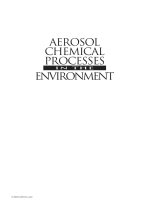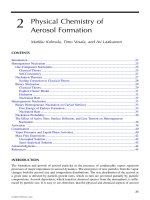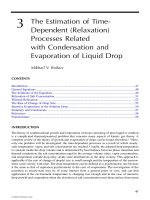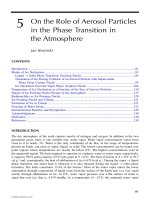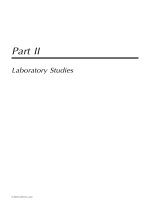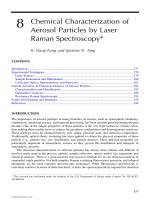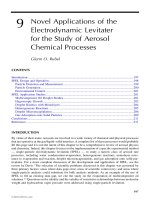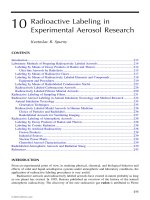AEROSOL CHEMICAL PROCESSES IN THE ENVIRONMENT - CHAPTER 1 pot
Bạn đang xem bản rút gọn của tài liệu. Xem và tải ngay bản đầy đủ của tài liệu tại đây (4.43 MB, 35 trang )
ENVIRONMENT
Aerosol
CHEMICAL
PROCESSES
IN THE
© 2000 by CRC Press LLC
Edited by
Kvetoslav R. Spurny
Special Editorial Consultant
Dieter Hochrainer
LEWIS PUBLISHERS
Boca Raton London New York Washington, D.C.
ENVIRONMENT
Aerosol
CHEMICAL
PROCESSES
IN THE
© 2000 by CRC Press LLC
This book contains information obtained from authentic and highly regarded sources. Reprinted material is
quoted with permission, and sources are indicated. A wide variety of references are listed. Reasonable efforts
have been made to publish reliable data and information, but the author and the publisher cannot assume
responsibility for the validity of all materials or for the consequences of their use.
Neither this book nor any part may be reproduced or transmitted in any form or by any means, electronic or
mechanical, including photocopying, microfilming, and recording, or by any information storage or retrieval
system, without prior permission in writing from the publisher.
All rights reserved. Authorization to photocopy items for internal or personal use, or the personal or internal
use of specific clients, may be granted by CRC Press LLC, provided that $.50 per page photocopied is paid
directly to Copyright Clearance Center,
222 Rosewood Drive, Danvers, MA 01923 USA.
The fee code for
users of the Transactional Reporting Service is ISBN 0-87371-829-1/00/$0.00+$.50. The fee is subject to
change without notice. For organizations that have been granted a photocopy license by the CCC, a separate
system of payment has been arranged.
The consent of CRC Press LLC does not extend to copying for general distribution, for promotion, for creating
new works, or for resale. Specific permission must be obtained in writing from CRC Press LLC for such
copying.
Direct all inquiries to CRC Press LLC, 2000 N.W. Corporate Blvd., Boca Raton, Florida 33431.
Trademark Notice:
Product or corporate names may be trademarks or registered trademarks, and are used
only for identification and explanation, without intent to infringe.
© 2000 by CRC Press LLC
Lewis Publishers is an imprint of CRC Press LLC
No claim to original U.S. Government works
International Standard Book Number 0-87371-829-1
Library of Congress Card Number 99-089288
Printed in the United States of America 1 2 3 4 5 6 7 8 9 0
Printed on acid-free paper
Library of Congress Cataloging-in-Publication Data
Aerosol chemical processes in the environment/ K.R. Spurny, editor.
p. cm.
Includes bibliographical references and index.
ISBN 0-87371-829-1 (alk. paper)
1. Aerosols Environmental aspects. I. Spurny, Kvetoslav.
QC882.42.A32 2000
541
.3′
.4515—dc21 99-089288
CIP
L829/frame/FM Page iv Wednesday, February 2, 2000 9:03 AM
© 2000 by CRC Press LLC
Dedication and Acknowledgment
This volume is dedicated to its editor, Kvetoslav R. Spurny, whose
untimely death on November 3, 1999 shocked and saddened all associ-
ated with its publication.
CRC Press/Lewis Publishers is privileged to have had a long-stand-
ing relationship with Dr. Spurny, whose deep interest in science, drive
to initiate and complete tasks, and kind personality are as integral to his
publishing file as the tangible documents therein. The Publisher sin-
cerely regrets that aerosol science has lost one of its founding fathers,
a great scientist, and a renowned contributor to the literature in this field.
Furthermore, the Publisher gratefully acknowledges Dr. Dieter
Hochrainer of Boehringer Ingelheim, Dr. Spurny's former colleague at the
Fraunhofer Institute, for his assistance in the final production of this book.
L829/frame/FM Page v Wednesday, February 2, 2000 9:03 AM
© 2000 by CRC Press LLC
Acknowledgments
The editor is extremely grateful to the authors for their excellent contributions. They have not only
contributed to broader information on the progress, state of the art, and new concepts in the field
of aerosol chemical processes, but they also have recognized the need for a monograph in aerosol
chemistry.
The editor would like to thank the staff of Lewis Publishers, a division of CRC Press LLC, for
their substantial help with the realization of this book. The authors are globally distributed and,
for the majority of them, English is not their mother tongue. Without the great, patient, and highly
professional support of the publishers, the realization of this book would not have been possible.
All — authors and publishers — have done an excellent job for aerosol science and aerosol
scientists.
L829/frame/FM Page vii Wednesday, February 2, 2000 9:03 AM
© 2000 by CRC Press LLC
Preface
Aerosol science today is an interdisciplinary branch of science that incorporates several environ-
mental, biological, and technological research fields. In a conference organized in Prague (Czech-
oslovakia) in 1962, we were able to bring together lecturers from different scientific fields —
physicists, chemists, meteorologists, biologists, physicians, hygienists, agrochemists, astrophysi-
cists, etc. — and from several different countries. The conference showed the important role of
aerosols and aerosol research in many basic and applied scientific and technological fields (Spurny,
K., Ed
., Aerosols, Physical Chemistry and Applications
, Academia Publ. House, Prague, 1965).
Furthermore, the interdisciplinary cooperation was found to be very useful and necessary. I
also remember the important role of chemistry in basic and applied aerosol research in a contri-
bution, published in 1971 (Spurny, K.R., A note on the development of the chemistry of aerosols,
J.
Aerosol Sci.,
2, 389, 1971). Now, being retired and 75 years old, I still feel that there is a need
for more synthetic work in aerosol chemistry, consisting of summarizing and evaluating the very
many aerosol chemical publications dispersed in the various journals among several disciplines.
Nevertheless, such a task is not easily realized. It is perhaps beyond the feasibility of one or
more editors to organize and compile a monograph like the
Aerosol Chemistry Handbook
, which
would include and describe all or the most important aerosol chemical processes involved in already
known scientific and technological areas.
We consider this book a partial contribution to such a task. We have picked up several examples
that show the impact of aerosol chemistry in several fields, mainly in basic and atmospheric research.
American, European, and Japanese colleagues have substantially contributed to the realization
of this book. I would like to thank them very much and hope their contributions will be helpful
and useful to the readers.
Kvetoslav R. Spurny
L829/frame/FM Page ix Wednesday, February 2, 2000 9:03 AM
© 2000 by CRC Press LLC
Editor
Prof. Dr. Kvetoslav R. Spurny
was Head of the Department of Aerosol Chemistry at the Fraunhofer
Institute for Environmental Chemistry and Ecotoxicology in Germany from 1972 to 1988. After
his retirement, he continued to work as an aerosol chemist. Prior to this, he was an environmental
chemist at the Institute for Occupational Hygiene in Prague (1952 to 1956) and Head of the
Department of Aerosol Sciences at the Czechoslovak Academy of Sciences in Prague (1957 to
1972). He was a Visiting Scientist at the National Center for Atmospheric Research, Boulder,
Colorado, (1966 to 1967) and Visiting Scientist at the Nuclear Research Center, Fontenay aux
Roses, France, in 1969.
Dr. Spurny obtained his diploma in Physics and Chemistry from Charles University, Prague,
in 1948, a Ph.D. in chemistry at the same university in 1952, and a C.Sc. as a Candidate of Chemical
Sciences at the Czechoslovak Academy of Sciences in Prague in 1964.
Professor Spurny was a member of the American Chemical Society, American Association for
the Advancement of Science, American Association of Aerosol Research, British Occupational
Hygiene Society, the New York Academy of Sciences, and was president of the Association for
Aerosol Research from 1983 to 1984. He wrote three books on aerosols and over 150 original
publications in aerosol physics and chemistry. In 1989, he was the recipient of the American David
Sinclair Award in Aerosol Sciences.
L829/frame/FM Page xi Wednesday, February 2, 2000 9:03 AM
© 2000 by CRC Press LLC
Contributors
Kai Bester
Institute of Organic Chemistry
Hamburg, Germany
János Bobvos
Municipal Institute of the State Public
Health Officer Service
Budapest, Hungary
Mikhail V. Buikov
Institute of Radioecology
Ukrainian Academy of Agricultural Sciences
Kiev, Ukraine
Miroslav Chomát
Institute of Radio Engineering and Electronics
Academy of Sciences of the Czech Republic
Prague, Czech Republic
I. Colbeck
Department of Biological Sciences
University of Essex
Colchester, U.K.
Marco Del Monte
Dipartamento di Scienze della Terra e
Geologico-ambientali
Bologna, Italy
K. Hang Fung
Department of Applied Science
Brookhaven National Laboratory
Upton, New York
Mario Gallorini
CNR
Centro di Radiochimica e Analisi per
Attivazione
Universitá di Pavia
Italy
Alexandra Gogou
Department of Chemistry
Division of Environmental and Analytical
Chemistry
University of Crete
Heraklion, Crete, Greece
A. Hachimi
Laboratoire de Spectrométrie de Masse et
Chimie Laser
IPEM
Metz, France
Heinrich Hühnerfuss
Institute of Organic Chemistry
University of Hamburg
Hamburg, Germany
Mark Z. Jacobson
Department of Civil and Environmental
Engineering
Stanford University
Stanford, California
Satoshi Kadowaki
Aichi Environmental Research Center
Nagoya, Japan
Ivan Kaˇsík
Institute of Radio Engineering and Electronics
Academy of Sciences of the Czech Republic
Prague, Czech Republic
G. Krier
Laboratoire de Spectrométrie de Masse et
Chimie Laser
IPEM
Metz, France
Markku Kulmala
Department of Physics
University of Helsinki
Helsinki, Finland
Ari Laaksonen
Department of Applied Physics
University of Kuopio
Kuopio, Finland
Claude Landron
Centre de Recherches sur les Matériaux à Haute
Temperature
Orléans, France
L829/frame/FM Page xiii Wednesday, February 2, 2000 9:03 AM
© 2000 by CRC Press LLC
Willy Maenhaut
University of Gent
Gent, Belgium
Vlastimil Matˇejec
Institute of Radio Engineering and Electronics
Academy of Sciences of the Czech Republic
Prague, Czech Republic
P. Mériaudeau
CNRS
Institut de Recherches sur la Catalyse
Villeurbanne, France
Javier Miranda
Department of Experimental Physics
Instituto de Física
Universidad Nacional Autónoma de México
México, D.F., Mexico
J.F. Muller
Laboratoire de Spectrométrie de Masse et
Chimie Laser
IPEM
Metz, France
Anders G. Nord
National Heritage Board
Satens Historska Museer
Stockholm, Sweden
S. Nyeki
Department of Biological Sciences
University of Essex
Colchester, U.K.
Vincent Perrichon
LACE–CNRS
Université Claude Bernard
Villeurbanne, France
E. Poitevin
Laboratoire de Spectrométrie de Masse et
Chimie Laser
IPEM
Metz, France
Jan Rosinski
Clouds and Precipitation Group
Istituto delle Scienze dell´Atmosfera e
dell´Oceano
Bologna, Italy
P. Rossi
Agenzia Regionale Prevenzione e Ambiente
Modena, Italy
Glenn O. Rubel
Department of the Army
R&T Directorate
SBCCOM-ECBC
Aberdeen Proving Ground, Maryland
Cristina Sabbioni
CNR
Instituto delle Scienze dell’Atmosfera e
dell’Oceano
Bologna, Italy
Imre Salma
KFKI Atomic Energy Research Institute
Budapest, Hungary
Kvetoslav R. Spurny
Aerosol Chemist
Schmallenberg, Germany
Euripides G. Stephanou
Department of Chemistry
Environmental Chemical Processes Laboratory
University of Crete
Heraklion, Crete, Greece
Ignatius N. Tang
Department of Applied Science
Brookhaven National Laboratory
Upton, New York
Timo Vesala
Department of Physics
University of Helsinki
Helsinki, Finland
Giuseppe Zappia
CNR
Scienze dei Materiali e della Terra
Universitá di Ancona
Ancona, Italy
´
Eva Zemplén-Papp
Hungarian Academy of Sciences
Budapest, Hungary
L829/frame/FM Page xiv Wednesday, February 2, 2000 9:03 AM
© 2000 by CRC Press LLC
Aerosol Chemistry
WHAT IS AEROSOL CHEMISTRY DEALING WITH?
An aerosol is a collection of fine and very fine particles dispersed in the gas phase. While
aerosol physics tries to describe the mechanical and dynamical behavior of this system and the
movement of particles in several force fields, and considers the single particle to be chemically
inert, aerosol chemistry involves the physicochemical and chemical properties of the particles, in
the chemical processes of particle generation, gas-to-particle and particle-to-particle reactions,
interface interactions, and — on a large scale — the chemical effects of particles in several
environmental fields and situations. Single aerosol particles are rarely inert; they are chemically
varied and reactive.
L829/frame/FM Page xv Wednesday, February 2, 2000 9:03 AM
© 2000 by CRC Press LLC
Editor’s Introduction
The physics and chemistry of aerosols have become generally adopted and are commonly in use
today. They fall under aerosol science. In general, aerosols, as dispersed systems, have the same
historical beginning and development as colloid chemistry. Both colloid chemistry and aerocolloids
(aerosols) originated approximately in the same time period, in the second half of the 19th century.
Thomas Graham, who was the first to distinguish between crystalloids and colloids in the 1860s,
is considered the founder of “classical” colloid chemistry. The first observations and identifications
of finely dispersed particles in gases, especially in air, were also made during this time period and
recorded by the most important scientists such as J. Tyndall (1870), M. Coulier (1875), J. Aitken
(1880), and L.J. Bodaszewsky (1881) et al.
The generic term,
aerosol
, evidently was coined by the well-known physicochemist F.G.
Donnan near the end of World War I (see Green, H. and Lane, W.
Particle Clouds
, Van Nostrand,
Princeton, NJ, 1969). A. Schmauss, a German meteorologist, was the first to introduce this term
into the literature (Schmauss, A., Kolloidchemie und meterologie,
Meteorol. Zschr
., 37, 1–8, 1920).
He had compared the properties and behavior of colloidal systems in liquids with dispersed systems
in gases. As an analogy to the term “hydrosol,” he used the designation “aerosol” for the aerocol-
loids. In the publication mentioned, he concluded that: “Between the aerocolloidal solutions and
the systems of solid and liquid particles in the atmosphere, large analogies do exist and therefore
the latter can be named aerosols, while the first ones are known as hydrosols.”
Physical investigations of aerosols were the domain of the classical period of aerosol science.
Greater practical interest in the properties of and processes in aerosol chemistry began during the
1950s. “Photochemical smog” was a new term at that time, and started to be used for the designation
of highly dispersed aerosols in the atmosphere of cities, which were heavily polluted by volatile
organics and gaseous and particulate emissions produced primarily by motor vehicles. This aerosol
is formed by several photochemical mechanisms and chain reactions in the air after intensive UV
irradiation. The first important observations and measurements date back to the 1950s (e.g., see
Haagen-Smit, A.J. et al.).
The importance of physicochemical processes — such as gas-to-particle conversion (or vice
versa), heterogeneous chemical reactions, etc. — was recognized. Important laboratory and atmo-
spheric investigations, including the development of mathematical models, have been undertaken
since the 1970s. Several laboratories and institutes have taken part in such research. In my opinion,
the most basic results were published at that time by S.K. Friedlander and his “school of aerosol
physics and chemistry” established initially at Cal Tech (California Institute of Technology) in
Pasadena and continued later at UCLA (University of California at Los Angeles). (See also
Friedlander,
S.K.,
Smoke, Dust and Haze
, John Wiley & Sons, New York, 1971). Friedlander, his
pupils, and coworkers were very successful in describing homogeneous and heterogeneous reactions
under laboratory and atmospheric conditions. John Seinfeld, Friedlander’s successor at Cal Tech,
and his staff are continuing with aerosol formation studies by developing, describing, and verifying
mathematical models. (See also Seinfeld, J.H.,
Atmospheric Chemistry and Physics of Air Pollution
,
John Wiley & Son, New York, 1985.)
Another important event dealing with the development of aerosol chemistry was the Conference
of Multiphase Processes in Albany, New York, in 1981 (Schryer, D.R., Ed.,
Heterogeneous Atmo-
spheric Chemistry,
Geophysical Monograph 26,
Am. Geophys.,
Union, Washington, D.C., 1982).
The published presentations of this conference showed that heterogeneous or multiphase chemical
processes play an important role in general atmospheric chemistry.
L829/frame/FM Page xvii Wednesday, February 2, 2000 9:03 AM
© 2000 by CRC Press LLC
The role of chemistry in the polluted atmosphere, as well as in several effects which atmospheric
anthropogenic aerosols produce in the total environment (e.g., deterioration of human health,
ecosystems, materials, etc.), is perhaps of greatest importance. Nevertheless, aerosol chemistry is
significantly involved in several technological fields as well.
A very important one is the technology of the production of new materials by means of aerosol
chemical reactions and processes. Virtually any material in the form of fine particles with controlled
compositions, microstructures, morphologies, and particle size (ranging from nanometer to micron
size) can be produced by means of this technology (Kodas, T., Ed., Aerosols in material processing,
J. Aerosol Sci.,
24, 271, 1993.).
A further field in which aerosol chemistry is involved is the technology of combustion processes.
Heterogeneous and particle surface chemical reactions are a very important part of the formation
and modification processes by aerosol production in burning gases, liquids, and powders (Kaup-
pinen, E.I., Ed., Combustion aerosols,
J. Aerosol Sci
., 29, 387, 1998).
It is clear that there exists no sharp dividing line between aerosol physics and aerosol chemistry.
Generally speaking, both are involved in the dynamics of any aerodispersed system and in its
effects. As mentioned, the literature dealing with aerosol chemistry is still rather widely dispersed,
and monographs summarizing and evaluating chemical studies in aerosols seem to be very desirable.
Kvetoslav R. Spurny
L829/frame/FM Page xviii Wednesday, February 2, 2000 9:03 AM
© 2000 by CRC Press LLC
Table of Contents
PART I
GENERAL ASPECTS
Chapter 1
Aerosol Chemistry and Its Environmental Effects 3
Kvetoslav R. Spurny
Chapter 2
Physical Chemistry of Aerosol Formation 23
Markku Kulmala, Timo Vesala, and Ari Laaksonen
Chapter 3
The Estimation of Time-Dependent (Relaxation) Processes Related to Condensation and
Evaporation of Liquid Drops 47
Mikhail V. Buikov
Chapter 4
Phase Transformation and Growth of Hygroscopic Aerosols 61
Ignatius N. Tang
Chapter 5
On the Role of Aerosol Particles in the Phase Transition in the Atmosphere 81
Jan Rosinski
Chapter 6
Reversible Chemical Reactions in Aerosols 135
Mark Z. Jacobson
PART II
LABORATORY STUDIES
Chapter 7
LAMMA and Raman Study of Oxidation States of Chromium in Aerosols: Application to
Industrial Hygiene 159
A. Hachimi, E. Poitevin, G. Krier, and J.F. Muller
Chapter 8
Chemical Characterization of Aerosol Particles by Laser Raman Spectroscopy 177
K. Hang Fung and Ignatius N. Tang
Chapter 9
Novel Applications of the Electrodynamic Levitator for the Study of Aerosol
Chemical Processes 197
Glenn O. Rubel
Chapter 10
Radioactive Labeling in Experimental Aerosol Research 213
Kvetoslav R. Spurny
L829/frame/FM Page xix Wednesday, February 2, 2000 9:03 AM
© 2000 by CRC Press LLC
PART III
AEROSOL SYNTHETIC CHEMISTRY
Chapter 11
Synthesis and Online Characterization of Zirconia Powder Produced by Atomization 249
Claude Landron
Chapter 12
Recent Developments in the Structural Investigation of Aerosols by Synchrotron Radiation:
Application to Ceramic Processing 257
Claude Landron
Chapter 13
Fundamentals and Performance of the MCVD Aerosol Process 271
Vlastimil Matˇejec, Ivan Kaˇsík, and Miroslav Chomát
PART IV
AEROSOLS AND BUILDINGS
Chapter 14
Aerosol Particles Deposited on Building Stone 297
Anders G. Nord
Chapter 15
Effects of Aerosol on Modern and Ancient Building Materials 309
Giuseppe Zappia
Chapter 16
Aerosol and Stone Monuments 327
Cristina Sabbioni
Chapter 17
Calcium in the Urban Atmosphere 347
Marco Del Monte and P. Rossi
Chapter 18
Corrosion of Asbestos-Cement Building Materials by the Action of Atmospheric Acidic
Aerosols and Precipitations 365
Kvetoslav R. Spurny
PART V
AEROSOLS IN THE ATMOSPHERE
Chapter 19
Characterization of Urban Aerosols in the Nagoya Area 379
Satoshi Kadowaki
Chapter 20
Analysis of Atmospheric Aerosols in Large Urban Areas with Particle-Induced
X-ray Emission 405
Javier Miranda
Chapter 21
Chemical Characteristics and Temporal Variation of Size-Fractionated Urban Aerosols
and Trace Gases in Budapest 415
Imre Salma, Willy Maenhaut, Éva Zemplén-Papp, and János Bobvos
L829/frame/FM Page xx Wednesday, February 2, 2000 9:03 AM
© 2000 by CRC Press LLC
Chapter 22
Trace Elements in Atmospheric Pollution Processes: The Contribution of Neutron
Activation Analysis 431
Mario Gallorini
Chapter 23
Urban and Rural Organic Fine Aerosols: Components Source Reconciliation Using an
Organic Geochemical Approach 457
Alexandra Gogou and Euripides G. Stephanou
Chapter 24
Elimination of Diesel Soots Using Oxidation Catalysts 487
Vincent Perrichon and P. Mériaudeau
Chapter 25
The Influence of Morphological Restructuring of Carbonaceous Aerosols on Microphysical
Atmospheric Processes 505
S. Nyeki and I. Colbeck
Chapter 26
Atmospheric Contamination by Fibrous Aerosols 525
Kvetoslav R. Spurny
Chapter 27
Atmospheric Contamination by Agroaerosols 559
Kvetoslav R. Spurny
Chapter 28
Transport and Chemistry of Pesticides in the Atmosphere 577
Kai Bester and Heinrich Hühnerfuss
L829/frame/FM Page xxi Wednesday, February 2, 2000 9:03 AM
© 2000 by CRC Press LLC
Part I
General Aspects
L829/frame/ch01 Page 1 Monday, January 31, 2000 2:20 PM
© 2000 by CRC Press LLC
3
1
Aerosol Chemistry and Its
Environmental Effects
K
vetoslav R. Spurny
CONTENTS
Introduction 3
Secondary Atmospheric Anthropogenic Aerosols 4
Formation, Transformation, and Characterization 4
Particle Size-Dependent Chemistry and Toxicology 4
Increasing Fine Particulate Emissions 9
Health Effects 10
Air Particulate Epidemiology 10
Toxicology of Fine Particulates 10
Clouds, Global Climatic Effects, and Ozone Depletion 12
Aerosols in the Forest Atmosphere 13
“Forest Aerosol” 13
Building Deterioration 15
References 18
INTRODUCTION
Two kinds of aerosols can be distinguished: “good” aerosols and “bad” aerosols. While the good
aerosols are useful in their applications and effects, the bad aerosols produce negative, harmful
effects on the environment and the human population.
Aerosol synthesis of nanoscale particles and powders belongs among the good aerosols. These
aerosol processes are currently used for the large-scale production of several modern materials,
1-4
such as alumina, silica, carbon black, uranium dioxide, titanium dioxide powders,
1
ceramic super-
conductors,
2
magnetic semiconductors,
3
etc.
Another field of application of good aerosols is their usage in the field of medicine (i.e., for
the production and application of diagnostic and therapeutic aerosols).
5
Although the distinction between good and bad aerosols is sharp, there do exist aerosols, for
which the effects can be positive as well as negative.
Agroaerosols
are such an example. Their
application in the protection of plants, forest, crops, etc. has a very positive impact on agricultural
development. On the other hand, agroaerosols can also produce negative effects on the health of
farms, on atmospheric and aqueous environments, on soils, etc.
Generally speaking, some of the good aerosols can also be harmful. The nano-sized particles
and powders produced in aerosol synthesis can be toxic when inhaled by humans. Unfortunately,
the majority of anthropogenic aerosols in the ambient air have negative impacts; for example, on
human health, on the living as well as nonliving environment, and on several atmospheric processes
(climate changes, ozone depletion, cloud formation, and other atmospheric processes). This short
L829/frame/ch01 Page 3 Monday, January 31, 2000 2:20 PM
© 2000 by CRC Press LLC
4
Aerosol Chemical Processes in the Environment
chapter attempts to summarize the effects of the bad aerosols to mainly the effects produced by
secondary atmospheric anthropogenic aerosols
(SAAA).
SECONDARY ATMOSPHERIC ANTHROPOGENIC AEROSOLS
Atmospheric anthropogenic aerosols are aerodispersed systems of solid and liquid particles with
different sizes, forms, and chemical compositions. Only a small portion of these particles — the
primary ones — which are dispersed into the atmospheric environment by wind from soils,
weathered rocks, deserts, sea spray, volcanoes, etc., are single inorganic or organic compounds.
The majority of atmospheric anthropogenic aerosol particles, especially the secondary ones, rep-
resent chemical mixtures. Also, the chemical composition of single particles can be anisotropic;
this means that the chemical composition is different, for example, on the surface and inside of
particles. Furthermore, the very fine particles can form agglomerates and, because of relatively
high specific surfaces, may adsorb or absorb volatile substances or gases. It will be shown later
that the single-particle chemistry is also a function of the particle size.
The size as well as chemical composition of the atmospheric anthropogenic aerosols are further
determined by emission sources. Therefore, a correlation exists between emission sources and
ambient air particle characteristics.
6-9
F
ORMATION
, T
RANSFORMATION
,
AND
C
HARACTERIZATION
The processes that impact species once they are released into the atmosphere involve a full spectrum
of chemistry and physics. The emitted gas and vapor molecules can react chemically in the gas
phase, can be absorbed into a particle or droplet where they might chemically react, can be
transported into the stratosphere, or can be removed by interactions with the Earth’s surface. Emitted
particles can coagulate with other particles, grow by absorption of vapor molecules, or be removed
at the Earth’s surface or incorporated into a water droplet.
10-12
The chemistry of air pollutants in the atmosphere — the formation, growth, and dynamics of
aerosols — the meteorology of air pollution, and the transport, diffusion, and removal of species
in the atmosphere are processes by which the total resulting atmospheric aerosol is characterized
(Figure 1.1).
13
A significant fraction of SAAA, such as sulfates, nitrates, ammonium, organics, etc.,
is produced in the atmosphere by combination of several physico-chemical processes: gas-phase
chemistry, aqueous-phase chemistry, condensation, adsorption, etc.
14
The formation of secondary organic aerosols is one of the most complicated processes in
heterogeneous atmospheric chemistry, involving oxidation of the precursor volatile organic com-
ponent, accumulation of the species of the secondary organic aerosol, and reversible transport to
the aerosol phase.
14-16
Useful and verified physico-chemical models are able to describe the formation of the SAAA
and predict their behavior and characterization at urban and regional levels.
11
The same is also valid
for modeling the physical processes that are involved in model aerosol dynamics. They are able to
determine aerosol size distribution functions in correlation with time and space.
17
The processes
affecting aerosol behavior are summarized in the Table 1.1 and Figure 1.2. The entire process can
then be expressed by the General Dynamics Equation first formulated by Friedlander in 1977 and
modified by Whitby and McMurry in 1997 (Figure 1.3).
17,18
P
ARTICLE
S
IZE
-D
EPENDENT
C
HEMISTRY
AND
T
OXICOLOGY
The mass distribution of particle sizes found in the atmosphere includes several modes. The
“nucleation mode” includes those particles with diameters less than 0.1
µ
m; these are termed
“ultrafine particles” or “highly dispersed aerosols.” This fraction includes “nanometer particles,”
defined as particles with diameters less than 50 nm.
19
L829/frame/ch01 Page 4 Monday, January 31, 2000 2:20 PM
© 2000 by CRC Press LLC
Aerosol Chemistry and Its Environmental Effects
5
FIGURE 1.1
Schematic picture showing the physical and physico-chemical processes in the development
of atmospheric aerosols. (From Reference 13. With permission.)
TABLE 1.1
Processes Affecting Aerosols
Internal Processes External Processes
Coagulation Diffusion
Fragmentation Convection
Particle Growth Particle migration due to external forces
Condensation/evaporation of vapors Deposition to surfaces in a closed system
Adsorption/desorption of gases Convection-like fluxes in an open system
Absorption of gases
(reactions on or within particles)
Internal sources/nucleation
Fraction of bulk-phase material
Reentrainment of particles from surfaces
L829/frame/ch01 Page 5 Monday, January 31, 2000 2:20 PM
© 2000 by CRC Press LLC
6
Aerosol Chemical Processes in the Environment
Electron microscopical and atomic force microscopical investigations of the atmospheric par-
ticle fraction less than 0.1
µ
m (PM-0.1) can be used to confirm the existence of “nano-particulates”
in the polluted atmosphere (Figure 1.4).
20
As particles less than 0.1
µ
m in diameter coagulate relatively fast (lifetime less than 1 h), from
the standpoint of sampling and measurement as well as from a toxicological standpoint, the
“ultrafine fraction” was recently defined as a fraction with particle diameters less than 1
µ
m. This
fraction then includes the “nucleation” mode and a large portion of the “accumulation” mode. It
is also designated as PM-0.1 (particulate matter). The fraction now designated as “fine particles”
is the fraction with particle diameters less than 2.5
µ
m; this fraction is also called the PM-2.5
fraction, and includes “nucleation” and “accumulation” modes. All particles with diameters below
10
µ
m are designated as the “respirable” or “thoracic” fraction and also as the PM-10 fraction. It
includes the “nucleation,” “accumulation,” and a portion of the “coarse” modes. TSP (total sus-
pended particles) is then designated as the fraction that includes the “nucleation,” “accumulation,”
and “coarse” modes.
TSP and PM-10 were first introduced and standardized in 1971.
21
The fractions PM-2.5 or PM-1
are now considered standardized.
22
Data exists regarding the relationships among the measured frac-
tions PM-2.5, PM-10, and TSP.
23
TSP (particles with aerodynamic diameters less than 50
µ
m) represents a very broad size range,
including PM-10, PM-2.5, and PM-1.
24
TSP, therefore, has a very poor toxicological definition.
PM-10 has been defined from a physiological standpoint only and represents the “thoracic” particle
fraction. TSP and PM-10 do not account for, correctly and sufficiently, the health risk potential of
particulate air pollutants. Their definitions neglect the role of particle chemistry and toxicity.
The PM-2.5 fraction, recently proposed and already used in routine measurements, seems to
be a much better standard that appears to account for the toxic and carcinogenic potential of
particulate air pollutants. PM-1 and PM-0.1, with particle sizes below 1
µ
m and 0.1
µ
m, respectively,
represent the “most toxic modes” of atmospheric anthropogenic aerosols. Both fractions are char-
acterized by high particle numbers and specific surfaces, while their mass concentrations are very
low.
From a toxicological standpoint, the chemical composition of the fine and ultrafine airborne
particles is of basic importance. Nitrates, sulfates, ammonia, and inorganic and organic carbon are
FIGURE 1.2
Aerosol dynamic processes for a control volume. (From Reference 17. With permission.)
External Forces
Diffusion
External Forces
Coagulation/Fracture
Nucleation
Adsorption
Desorption
Diffusion
Inflow
Condensation
Outflow
L829/frame/ch01 Page 6 Monday, January 31, 2000 2:20 PM
© 2000 by CRC Press LLC
Aerosol Chemistry and Its Environmental Effects
7
the most abundant species in the PM-2.5 fraction. This fraction predominantly incorporates metals
such as V, Cr, Mn, Zn, Se, Pb, Ni, Cd, Pt, Pd, Rd, etc. In a recent study,
25
ultrafine atmospheric
particles (PM-0.1) sampled in the Los Angeles area were characterized by physical and chemical
parameters. The measured particle number concentrations were found to be in the range of 10
4
particles per milliliter of air. The mass concentrations were in the range of 1
µ
g m
–3
. Organic
compounds were the largest contributors to ultrafine mass concentrations. A small amount of sulfate
was present in these particles. Iron was the most prominent transition metal found in ultrafine
particles (Figure 1.5). The toxic and carcinogenic organic particulate compounds are highly dis-
persed aerosols. The polycyclic aromatic hydrocarbons (PAHs) belong among the most common
ubiquitous organic air pollutants. They are present in the atmosphere as volatile and semivolatile,
but mainly as fine and very fine particulates. It can be demonstrated that the PAHs and their
derivatives are bounded practically on fine and very fine particulates.
26,27
The majority of such particles with PAHs and other organic toxicants are produced by com-
bustion processes. Diesel vehicles are one of the major sources of fine, atmospheric toxic particulate
matter in urban environments. Submicron diesel-particle mass size distributions display three log-
normal modes that are centered at 0.09, 0.2, and 0.7–1.0 mm of particle aerodynamic diameter
(Figure 1.6). The size distributions of elemental carbon (EC) and organic carbon (OC) are quite
different: EC peaks at 0.1 mm, and OC peaks between 0.1 and 0.3 mm.
28
FIGURE 1.3
General dynamic equations for aerosols formulated by Friedlander (I) and by Whitby and
McMurry (II). (From Reference 17. With permission.)
L829/frame/ch01 Page 7 Monday, January 31, 2000 2:20 PM
© 2000 by CRC Press LLC
8
Aerosol Chemical Processes in the Environment
In vitro
cyto- and genotoxicity tests have been used to evaluate the inhalation hazard from
airborne particulates.
29
Furthermore, the application of
in vitro
procedures makes it possible to
correlate the genotoxicity, mainly the mutagenicity, to physical (e.g., particle size) and chemical
(e.g., PAHs, etc.) properties of air particulate samples.
Investigations of basic importance were realized in the urban air of the city of Bologna (Italy).
30
The mutagenicities of total (PM-10) and of particle size fractions-particle diameters, in mm:
FIGURE 1.4
An example of the aerodynamic (aed) distribution of atmospheric aerosols (Vienna, Austria)
in the nanometer size region. (From Reference 20. With permission.)
FIGURE 1.5
The mass distribution of the composition of wintertime fine and ultrafine particles measured
at Pasadena, CA. (From Reference 25. With permission.)
14
12
10
8
6
4
2
0
5
15 25 35 45 55 65 75 85 95 105 115 125 More
aed (nm)
aed size distribution
Frequency (%)
L829/frame/ch01 Page 8 Monday, January 31, 2000 2:20 PM
© 2000 by CRC Press LLC
Aerosol Chemistry and Its Environmental Effects
9
0.4: 0.4–0.7; 0.7–1.1; 1.1–3.3
of urban air particulates were identified using tests on
Salmonella typhimurium.
There was no
correlation between total or coarse-particle concentrations in air and the mutagenic activity. The
correlations increased as particle size decreased; moreover, the finer the particles, the greater the
mutagenicity (Figure 1.7). Therefore, the PM-10 concentrations do not appear to be representative
of air quality, at least with regard to mutagenicity. PM-2.5 seems to combine a better air quality
concept with effective health risk.
I
NCREASING
F
INE
P
ARTICULATE
E
MISSIONS
Since about 1980, important changes in the physical and chemical characterizations of air pollutants
have been observed and quantitatively determined.
31-34
The previous heavy pollutions by coarse
dusts and dark smokes disappeared from the skies of cities in highly developed countries. The
emission situation has changed considerably in these countries, mainly due to improved burning
and dust abatement technologies. Today, particulate emissions from transportation fuel combustion,
etc. contain fine aerosols, with particle sizes less than 2
µ
m. The coarse particulates in industrial
emissions are very efficiently removed by modern air-cleaning equipment, but fine and very fine
particulates penetrate into the atmospheric environment.
While the concentrations of coarse particles (approximate size range of 2 to 10
µ
m) have
considerably decreased, an increasing tendency of the concentration of fine (particle sizes less than
2.5
µ
m) and ultrafine (particle sizes less than 1
µ
m) particles has been confirmed in several more
recent observations and measurements.
33,34
Therefore, the decrease in emitted particulates from different sources does not imply a simul-
taneous reduction in the fine particle fraction. For example, the newer diesel engine (1991) produces
less mass of soot particles, but has increased emissions of ultrafine soot particles in comparison
with the previous (1988) diesel engine. This could occur if the newer engine causes incomplete
FIGURE 1.6
The size distribution (particle diameter D
p
) of particles emitted in diesel engine exhaust.
(From Reference 27. With permission.)
L829/frame/ch01 Page 9 Monday, January 31, 2000 2:20 PM
© 2000 by CRC Press LLC
10
Aerosol Chemical Processes in the Environment
burn-out of soot particles, causing particle agglomerates to disintegrate.
25
An increased production
of fine and very fine particulate emissions seems to be the characteristic development in atmospheric
pollution at the present time.
HEALTH EFFECTS
The results of existing toxicological studies (
in vitro
and
in vivo
) suggest that both physical (particle
size, shape, surface, and biopersistence) and chemical (solved and leached toxic chemicals, and
surface catalytic reactions) properties of fine (PM-2.5) particulate fractions are involved in several
health effects.
A
IR
P
ARTICULATE
E
PIDEMIOLOGY
Recent epidemiological studies that have examined particulate air pollutant concentrations in
relation to health statistics conclude that elevated fine-particle matter concentrations (PM-2.5) are
associated with increased mortality and morbidity in the general population, and especially in
vulnerable children and elderly persons.
34-37
Figure 1.8 summarizes the results of such investigations. The ambient air concentrations of
fine particulates (PM-2.5) correlate well with excess mortalities of six U.S. cities.
37
Correlation
with the concentrations of the PM-10 particulate fraction was not satisfactory.
T
OXICOLOGY
OF
F
INE
P
ARTICULATES
The mechanisms responsible for the observed increases in mortality and morbidity are virtually
unknown. Nevertheless, there seems to be clear evidence that specific components of the air
particulates alone, or as components of mixtures with other pollutants, produce adverse biological
FIGURE 1.7
Mutagenic activity of air particulates as a function of particle diameter, indicated in net
revertants per cubic meter air. (From Reference 30. With permission.)
L829/frame/ch01 Page 10 Monday, January 31, 2000 2:20 PM
© 2000 by CRC Press LLC
Aerosol Chemistry and Its Environmental Effects
11
responses consistent with human morbidity findings.
34,36
Results of some recently published epi-
demiological studies, as well as animal inhalation experiments, support the hypothesis that physical
and chemical properties of single particles are involved in the toxic, genotoxic, and carcinogenic
health effects of inhaled atmospheric particulates. Particle size, shape, and electric charge, partic-
ulate surface, and solubility are the most important physical parameters that have been correlated
with the observed toxic effects. These parameters also influence substantially the particle lung
deposition and lung clearance rates. Fine and very fine particles penetrate into the deep lung
compartments, and their deposited fraction depends strongly on particle diameter and breathing
rates. Furthermore, the electric charge of fine particles enhances airway deposition. Similarly,
particle lung clearance depends on particle size. The hypothesis that fine and very fine particles,
when inhaled, can be very toxic to the lung is therefore supported by their high deposition efficiency
in the lower respiratory tract, by slow clearance rates, by their large numbers per unit mass, and
by the increased surface areas available for interactions with cells. Fine and very fine particles have
been shown to be highly toxic to rats. They are poorly taken up by lung macrophages and are
capable of penetrating the pulmonary epithelium into the interstitium.
38-44
In several investigations, the dependency on chemical composition of inhaled air particulates
was also proved.
44
Particle–cell interactions potentially could be amplified by the presence of
radicals on their surfaces. Transition metals (e.g., Fe, Mn, V, Ni, Ti, etc.), which are the most
important inorganic constituents of air particulates, release in interactions with cells metal ions;
for example, ferric ions, which catalyze the production of hydroxyl free radical via the Fenton
reaction.
45
The free radical activity of particle surfaces may have several “damaging” effects on
cells with which they make contact: lipid peroxydation, protein oxidation, DNA strand breaks,
antioxidant depletion.
There also exists a direct production of short-lived free radicals (OH, HO
2
, H
2
O
2
) in particulates
in the air by several chemical reactions. Their concentrations are approximately one order of
magnitude higher in polluted urban regions than in rural and remote areas.
46
Particle toxicity and carcinogenicity are also enhanced by numerous organic constituents (e.g.,
PAHs, oxy- and nitro-PAHs, etc.) that are adsorbed or absorbed on and in fine and ultrafine insoluble
particulates.
47-49
The majority of such particles with organic toxicants are produced by combustion
FIGURE 1.8
Estimated adjusted mortality rate ratios and pollution levels (PM-2.5) in six U.S. cities:
Portage, WI (P); Topeka, KS (T); Watertown, MA (W); St. Louis, OH (L); Harrison, TN (H); and Steutenville,
OH (S). (From Reference 37. With permission.)
L829/frame/ch01 Page 11 Monday, January 31, 2000 2:20 PM
© 2000 by CRC Press LLC
